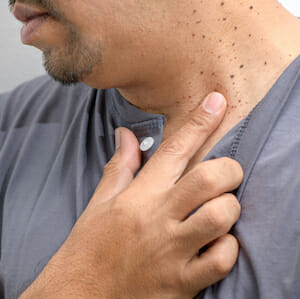Can Skin Tags Be Cancerous?
- Posted on: Mar 7 2022

asarch blog can skin tags be dangerous
Though skin tags are harmless and not usually cause for alarm, they can develop in inconvenient areas, such as your neck and underarms. They can also cause discomfort and may even irritate your skin if they develop in a place that is subject to constant movement or that creates friction against clothing, such as the neckline. Explore your options for skin tag removal and learn why you should never attempt to remove them on your own.
What Are Skin Tags?
Skin tags are a common type of skin growth that are attached to the skin by a short stem. They’re usually the same color as your skin, but they can also be slightly darker. Most skin tags are about the size of a pebble, although they can also become larger.
Can Skin Tags Be Cancerous?
No, skin tags are not normally cancerous. However, without a thorough examination by a doctor, what you believe to be a skin tag may actually be something different. It’s important that you check with an experienced Asarch dermatologist before taking any action. A cluster of skin tags could also indicate a more serious problem, so be sure to tell you doctor if you have something similar.
What Causes Skin Tags?
The exact cause of skin tags is unknown, but one possibility is excessive cell growth. Skin-on-skin friction can also lead to skin tags. That’s why skin tags often develop on areas of the body where the skin is folded or creased, such as the eyelids, armpits, groin, and under the breasts. While skin tags can affect anyone, the likelihood of developing skin tags increases with age. People who have diabetes or are overweight are also more likely to develop skin tags. Changes in hormone levels, including during pregnancy, can also increase your risk of skin tags. You’re also more likely to develop skin tags if you have a family history.
Why You Shouldn’t Remove Skin Tags at Home
For bothersome skin tags that frequently rub against jewelry or clothing, you might be tempted to remove them at home. DIY skin tag removal options and over-the-counter products aren’t recommended for skin tags, especially skin tags that grow in sensitive places. Here are a few reasons why self-removal options are unsafe and why you should always see a dermatologist for skin tag removal:
It might not be a skin tag: Though rare, a growth you think is a skin tag may be something else entirely, such as a wart, mole, or even skin cancer. That’s why you should have a dermatologist assess any potential skin tag before proceeding with removal.
Risk of bleeding or scarring: Since skin tags contain blood vessels, removing a skin tag by yourself with nail clippers or scissors increases your risk of bleeding. There’s also a chance of infection and scarring associated with removing a skin tag yourself.
Damage surrounding tissue: Attempting to remove a skin tag from a small and delicate area can harm the surrounding tissue.
Seeing a dermatologist is the quickest and safest way to remove skin tags. Our Asarch dermatologists have the expertise needed to safely remove skin tags and eliminate problems like infection, scarring, and bleeding.
How to Remove Skin Tags
Most skin tags don’t cause any problems, but you can have them removed if their appearance bothers you or if they cause discomfort by rubbing against your clothing or jewelry. Skin tag removal by a dermatologist is a quick and painless procedure. Our dermatologists treat different types of skin tags that occur anywhere on your body. Depending on the location and size of your skin tag, your dermatologist may recommend one of these removal procedures:
- Cryotherapy: This treatment option uses extreme cold to freeze off skin tags. Your dermatologist will soak a cotton swab or tweezers in liquid nitrogen and apply it directly to the skin tag. Within a week or two, the frozen skin tag falls off your skin.
- Scissor excision: After numbing the area, your dermatologist cuts off the skin tag using special medical-grade scissors.
- Electrosurgery: This procedure uses high-frequency electrical energy to burn the skin tag at its base. Burning off the skin tag helps control bleeding during removal.
- Ligation: During a ligation procedure, your dermatologist cuts off blood flow to the skin tag by tying off the base. After a few weeks, the skin tag naturally falls off.
Can You Prevent Skin Tags?
Although skin tags aren’t preventable, there are steps you can take to reduce your risk. Avoid wearing jewelry that irritates your skin. Choose soft, breathable fabrics instead of tight clothing that rubs against your skin. Exercising regularly and eating a healthy diet can reduce your risk of obesity and diabetes, which are common risk factors associated with the development of skin tags.
If you have a bothersome skin tag on your body, the skincare experts at Asarch Dermatology can help. To learn more about your treatment options, contact us today to make your appointment. We have three convenient locations in Englewood, Castle Rock, or Lakewood, CO.
